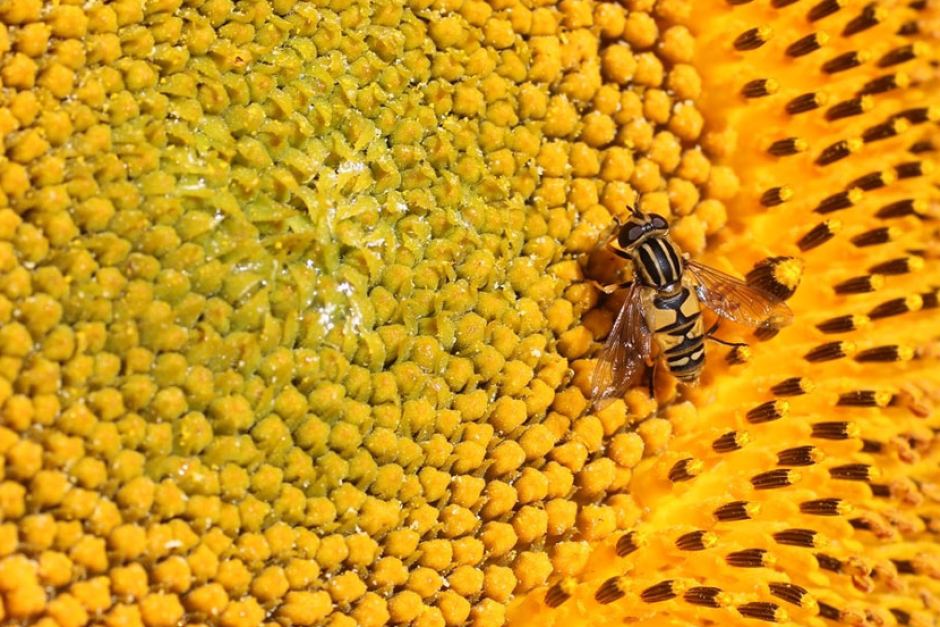Bees are responsible for the pollination of many vital crops, but bees aren't the only ones to pick up the workload.

A hoverfly on a sunflower. David Kleijn
We hear a lot about bees and how important they are for growing our crops. Well, they are – and we should also be concerned about recent declines in bee populations and their health. But bees aren’t the only pollinators. Our recent global analysis has revealed that the “non-bee” insects are playing much bigger roles than had been appreciated.
These wild insect pollinators occur naturally in our crops and are not deliberately managed by growers. Among the important insects are bees, flies, beetles, butterflies, moths and wasps. We know that these other pollinators can be very important. For instance, the contribution by wild pollinating insects other than bees in oilseed rape in Sweden varied from 5-80%.
In Australia, we’re not so sure. We need to make sure that in our focus on bees, we don’t ignore our other pollinators.
Pollination makes the world go ‘round
Overall, about three-quarters of all the world’s food crops and a third of the food we eat by volume, comes from pollinator-dependent crops.
Different crops vary in their need for animal pollination. Some crops, such as almonds, melons and passionfruit need pollination in order to produce their fruits or nuts, while others like carrots and onions, need pollination only for seed production.
In Australia we grow a huge range of crops in environments ranging from tropical to cooler climates. We are the world’s second largest exporter of canola and grow this crop across much of the southern half of the continent (in every state except the NT) and we also produce tropical crops such as mango that can grow across much of the top half of the country.
For every crop there can also be a range of different varieties, which can vary in how much they depend on pollinators.
A couple of recent studies have shown that the ubiquitous European honey bee underperforms compared to other species when it comes to pollination.
For example, research on blueberry in North America has found that some wild bee species visit more flowers and transfer more pollen between flowers, compared to honey bees.
The ‘other pollinators’
Most crop pollination studies focus on bees (domesticated and wild) because they have the strongest biological association with flowers.
Our recent study revealed that the contribution by pollinators other than bees varied a lot within and among crops and locations.
So what does this mean for Australian crops?
Well, we don’t know which pollinators visit every Australian crop in every growing region and we can’t predict what the pollinator community will be. This is a huge knowledge gap considering that wild pollinators contribute so much to crop pollination generally.
We know a little about custard apples, almonds, mangos, canola and a few other crops but have little idea of who are the pollinators for many other pollinator-dependent crops in Australia, let alone variation in what type of pollinators are found where and with which other pollinators.
Looking after our pollinators
We know that bees need somewhere to make their nests, as well as flowers to feed their young. Because of these needs, natural habitats such as trees and other woody vegetation are often associated with more bees visiting crops and more different species of bees.
Yet, we know very little about how habitat affects crop pollination from insects other than bees. Flies and beetles have quite different adult and larval stages, which usually have quite different resource needs.
For example, hoverflies can feed on aphids or decaying plant matter as larvae and then need nectar and pollen as adults. Understanding what these pollinators need will help us protect them and manage them better on farms.
In Australia, we have few measures for growers to protect habitats and manage biodiversity.
In Europe schemes provide payments to farmers in return for a service of benefit to biodiversity and conservation. These schemes include creating wildflower strips, reducing the use of chemicals, organic farming, converting farmland to grassland, cover crops, buffer strips, reducing water use, and maintaining landscape features (such as isolated trees, hedges and stone walls, allowing public access, set asides). Farmers sign a contract and are paid for the cost of meeting certain commitments, and compensated for any losses of income due to reduced production. Like most land management initiatives, these schemes have their share of challenges, but targeted schemes can have positive benefits for crop yields and wild pollinators.
We still have a lot of knowledge gaps to fill, but we are also in a great position to do this. Australia’s pollinator insect fauna is unique and diverse. Investing in building our knowledge of these species and their ecology will ease the pressures on our managed honey bees and have ongoing biodiversity and crop production benefits across Australia.
This article was originally published on The Conversation. Read the original article.


Pingback: Fact check: Is two-thirds of Australia's food production reliant on bee pollination? – Fact Check | Australian Cafe news and updates.
28th January 2016 at 11:29 am
To what extent does “The Pill” interfere with the life cycle of pollination insects and other animals living in water?
28th January 2016 at 1:30 pm
Hi Bruce. Indeed, the hormones in contraceptives can accumulate in waterways, interfering with the biochemistry of wildlife. The topic is outside the scope of this article, but here’s a helpful article to address some general questions you might have: https://www.arhp.org/publications-and-resources/contraception-journal/august-2011.
Regards,
Jesse